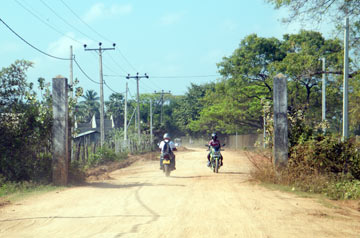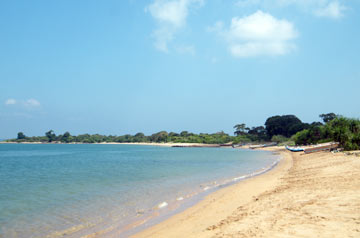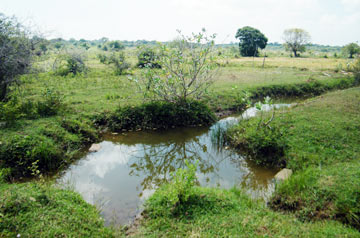|
Sampur Power Project draws local ire:
Opposed!
by Rukshana Rizwie
Land levelling and fencing at the controversial 500 megawatt proposed
coal power plant has begun in Sampur, Trincomalee. Authoritative sources
at the Ministry of Power and Energy told the Sunday Observer that the
project has hit an unexpected snag. Fierce opposition from
environmentalists and residents lobbying for a relocation of the plant
were unfavorable and could bring construction work to a grinding halt.
 |
| Road leading
to the controversial power plant |
 |
| Shrub land in
close proximity |
 |
| Picturesque
Koddiyar Bay |
 |
| The proposed
site for the plant |
"The parameters of the project are unknown; people felt that their
lands were being encroached by the state who pledged it to India for the
project and the boundaries have been bulldozed," said T.Gopahan, an
activist who heads the People's Forum Against the Sampur Power Plant in
Trincomalee.
At present 515 acres in Sampur have been designated as the proposed
site for the coal power plant. The power plant is a joint venture
between the Ceylon Electricity Board (CEB) and the National Thermal
Power Corporation Ltd. (NTPC) of India and is expected to be linked to
the national grid by 2017.
Restricted access
Gopahan said three undred families who live within the 100m buffer
zone of the proposed site have filed cases on the demarcation. "300
families live in the Kadakkarachennai village which would be the
entrance to the proposed site. Based on the survey by the Green
Trincomalee Movement, we found that 30 families will lose their lands
partially and 40 will have restricted access to the coast," he said.
"For years this resilient community managed on their own," he said.
"They engaged in agricultural activities, depended on 10 feet wells in
the backyard, while animal husbandry was their main source of income,"he
said.
Opposition leader and Tamil National Alliance (TNA) chief
R.Sampanthan said the matter was very much on his mind. "I am told of
the impact the plant will have on the community's livelihood, the
substantial environmental and health hazards," he said. "I am concerned.
being a representative in Parliament from the Trincomalee district I
wasn't consulted."
Sampanthan said that he would take up the matter with the relevant
authorities in the coming days."The project and this process needs to be
thoroughly thought out," he said.
Gopahan said the process has not been transparent nor interactive
because residents and environmentalists were not consulted. "When the
Environment Impact Assessment (EIA) was prepared in 2011 there were not
many people in the area. Paddy fields and tanks were abandoned," he
said. "The EIA did not factor the number of people, their livelihood or
the fisher folk."
The Central Environment Authority (CEA) after a lapse of over a year,
granted approval under stringent conditions for the power plant project
to begin operations last month. Chairman of the CEA Prof. Lal Dharmasiri
said the CEA was closely monitoring the project. He added the CEA's
approval was granted after a study of the EIA Report by the Trincomalee
Power Company Limited.
The EIA of the plant suggests several changes to the initial project
but does not delve deeply into the environmental issues or impacts the
plant will have on the livelihood of residents nearby.
Under 'social aspects,' the EIA cites that people directly affected
due to the project should be compensated. The project proponent is also
requested to ensure that existing fishing and fisheries activities were
not disturbed and any impact should be compensated. The EIA also states
that fisherfolk in the area should be made aware of the impact of the
plant.
"The villagers have not been told by the project proponent but they
well aware of the effect this plant will have on their health," Gopahan
said. "The contamination of ground water and the environmental effect on
aquatic species are real and lethal."
Austin Fernando, Governor of the Eastern Province said he was yet to
be told of the adverse effect the plant would have on the community. "I
have heard that people are protesting against the initiating of the
plant," he said. "I've not been approached personally, neither do I know
in detail the effect this plant will have on the people,"he said.
Cumulative impact
When we asked the Secretary to the Ministry of Power and Energy on
the matter, he said "The problems were resolved, because the EIA had
cleared those doubts.""If that's not the case, then it's only wise for
the people to come forward with their grievances."
Representatives of the Environmental Foundation Limited(EFL) who
toured the site say the EIA does not include the cumulative impact on
the agricultural fields and the quality of air to which these residents
will be exposed to.
A report on their assessment cites that heavy metals and smog from
the plant will affect air quality causing while disposing of the sludge
from the scrubbers will cause an accumulation of heavy metals and
radioactive elements in dumping sites. The chemicals in the sludge will
then leach into the ground water, affecting people for generations to
come.
According to US-based Union of Concerned Scientists a 500 MW coal
fired plant will annually release 10,000 tons of Sulfur Dioxide (the
main cause of acid rain); 10,200 tons of Nitrogen Oxide, which causes
smog; 3.7 million tones of CO2, a leading cause of global warning; 500
tons of small particles which cause lung damage; 720 tons of Carbon
Monoxide, which causes global warming and 2.2 billion tons of warm
water, which when released into the sea will bleach corals and destroy
marine life.
In a letter addressed to President Maithripala Sirisena highlighting
these concerns, EFL noted the project contradicts the government's
policy of a 'Blue-Green Era' which pledges to fight global warming and
adopt low carbon emission.
When authorities of the the Trincomalee Power Company were contacted
on Friday, Managing Director, Praveen Saxena was reportedly in India on
an official visit regarding the project.
Photos: EFL
Environment Foundation assessment
• Emissions from coal combustion will produces harmful compounds,
including Sulphur dioxide, Nitrogen Oxides, Hydrocarbons, Carbon
monoxide and several heavy metals such as Mercury, Arsenic, Lead,
Cadmium, and even quantities of Uranium and Thorium.
• Scientific evidence shows that the fly ashes produced by the plant
contain radiation.
• Sulphur dioxide and Nitrogen oxides are the primary cause of acid
rain. The proposed location of the coal plant is in the path of the
northeast monsoon, causing winds to carry the acid rain into the central
hills
• The rivers that flow into the northeast originate from the
mountains, and will carry acid and fly ash-laden water to the
agricultural areas.
• The EIA Report does not include the cumulative impact on the
agricultural fields and the quality of air to which these IDPs will be
exposed.
• The acid rain, fly ash and smog will affect most important cultural
monuments in the Cultural Triangle such as the Stupas, Sigiriya, Namal
Uyana to name a few.
• Disposing of the sludge from the scrubbers will cause an
accumulation of heavy metals and radioactive elements in dumping sites.
• The proposed power plant will use up to 90,000 m3 of water per hour
to produce steam and for cooling the system after generating
electricity. Sea water from Koddiyar Bay will be used for this process
and discharged into Shell Bay, which has a very high biodiversity and
supports a very sensitive marine ecosystem. Even a slight rise in the
temperature is proven to cause damage to the corals.
A constant release of high temperature water into the Bay could
irreversibly damage this ecosystem.
Source: EFL |

